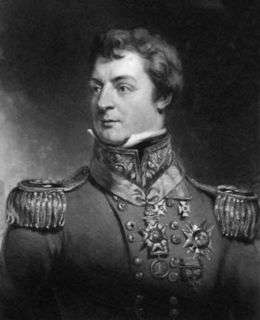Sir James Carmichael-Smyth, 1st Baronet
- This article concerns the colonial administrator. For his father, the Scottish physician, see James Carmichael Smyth (physician)
| Sir James Carmichael-Smyth, Bt | |
|---|---|
 | |
| Born |
22 February 1779 London, England |
| Died |
4 March 1838 (aged 59) Georgetown, Guyana |
Sir James Carmichael-Smyth, 1st Baronet, KCH, CB (22 February 1779 – 4 March 1838) was a British Army officer and colonial administrator.
Life
Carmichael-Smyth was born in London the eldest son of doctor and medical writer, James Carmichael Smyth and Mary Holyland. He was educated at Charterhouse School and the Royal Military Academy in Woolwich, London before joining the Royal Engineers in March 1795 as a second lieutenant. One of the chief engineering officers of the British Army in Southern Africa between 1795-1808, he then went to Spain under Lieutenant-general Sir John Moore in 1808-9. From 1813-15 he was stationed in the Low Countries and was present at the ill-fated Siege of Bergen op Zoom in 1814 before going on to command the Royal Corps of Engineers & Sappers at Waterloo.[1] Prior to the battle, Smyth had created a plan of the ground that allowed Wellington to place his troops rapidly and advantageously.[2]
He died on 4 March 1838 in Georgetown, Guyana.
Family
Carmichael Smyth married Harriet Morse, daughter of Robert Morse, on 28 May 1816 and they had one son.[1]
Notes
- 1 2 Raudzens 1988
- ↑ Dalton 1904, p. 229.
References
- Raudzens, George K. (1988). "Smyth, Sir James Carmichael". In Halpenny, Francess G. Dictionary of Canadian Biography. VII (1836–1850) (online ed.). University of Toronto Press. OCLC 53361801.
- Dalton, Charles (1904). The Waterloo roll call (2nd ed.). London: Eyre and Spottiswoode. p. 229. OCLC 263174459, 847974743, 558745289.
Further reading
 Vetch, Robert Hamilton (1898). "Smyth, James Carmichael (1779-1838)". In Lee, Sidney. Dictionary of National Biography. 53. London: Smith, Elder & Co. pp. 185–186.
Vetch, Robert Hamilton (1898). "Smyth, James Carmichael (1779-1838)". In Lee, Sidney. Dictionary of National Biography. 53. London: Smith, Elder & Co. pp. 185–186. - Saunders, D. Gail (1986). "Personalities: Sir James Carmichael Smyth, 1779–1838". Journal of the Bahamas Historical Society. 8 (1): 22.
| Government offices | ||
|---|---|---|
| Preceded by Lewis Grant |
Governor of the Bahamas 1829–1833 |
Succeeded by Blayney Balfour |
| Preceded by Sir Benjamin d'Urban |
Governor of British Guiana 1833–1838 |
Succeeded by Henry Light |
| Baronetage of the United Kingdom | ||
| New creation | Baronet (of Nutwood) 1821–1838 |
Succeeded by James Robert Carmichael |